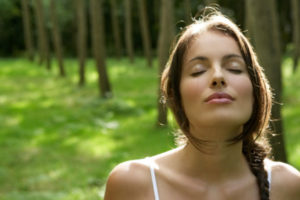It’s often the most basic things in life that can yield the most benefits. I’ve talked before about how reverting back to our more simple and natural ways is a significant way to improve health, and that the increasingly modern and technological-overloaded lifestyle is severely harming our health. Perhaps nowhere else is this more evident than most people’s relationship with light, both sunlight and artificial. As you will see, this is another very basic factor that is often overlooked yet has an enormous impact on one’s health.
Circadian Rhythm
First, it is important to understand the concept of the circadian rhythm. The circadian rhythm is the internal “clock” that is in all humans and tells our bodies when to sleep, rise, and eat, for example, and regulates many bodily processes (Psychology Today, 2019). And one of the most beneficial ways to regulate this circadian rhythm is to get exposed to natural sunlight in the morning and throughout the day and limit artificial light at night. Yet, many people today seem to do the opposite.
Many people wake up and go directly to their jobs where they are indoors all day, and then at
Importance of Melatonin
We are diurnal beings, meaning we are meant to be active and outdoors during the day, and less active/indoors at nights (Mead, 2008). Our circadian rhythm is responsible for this, mainly through the action of melatonin. Melatonin is a hormone produced by the pineal gland and acts as a “pace-setter” for the circadian rhythm (Mead, 2008). In natural conditions, melatonin is produced predominantly after the sun sets and throughout the night, helping you to sleep, and its production stops once you are exposed to sunlight in the morning, making you feel more alert and energized (Mead, 2008).
Sunlight Exposure Throughout the Day
So, one of the first things you can do each day to help regulate this rhythm is get exposed to sunlight as soon as you wake up in the morning (DiClementi, 2016). Doing this sends a message to your body that it is daytime and that you should be active and alert. Furthermore, it also leads to melatonin being produced sooner at night, which helps you to fall asleep faster (Mead, 2008).
Serotonin
Also, sunlight exposure during the morning and throughout the day has many other benefits. First, it is important to talk about another hormone, serotonin. When we are exposed to sunlight during the day, it leads to the production of more serotonin (Mead, 2008). And since serotonin is one of the “feel-good” neurotransmitters, increasing this hormone can result in a more positive outlook, increased mood, and general feelings of well-being (Mead, 2008). Just think of all of the times you’ve gone outside on a really sunny day (particularly in the Summer), and how good it makes you feel.
Also, you may have heard of Seasonal Affective Disorder (SAD), which is essentially seasonal depression that occurs during the fall and winter months. This is primarily due to lack of sunlight, and sunlight exposure during these months can be a very effective way to ward off SAD and improve one’s mental health (Mead, 2008). Even if you don’t have SAD, sunlight exposure becomes increasingly important for everyone in the fall and winter months, mainly because no one gets outside hardly ever, compared to the spring and summer months.
Also, serotonin has another very important role because it actually converts to melatonin in the presence of darkness (Mead, 2008). So, if you are exposed to more sunlight during the day you will produce more serotonin, and as a result, you will produce more melatonin at night leading to more restful sleep and optimal sleep-wake cycle. Of course, that is if you aren’t harming your melatonin production at night, which is another important thing that will be talked about shortly.
A Variety of Other Benefits
Another tremendous benefit of sunlight exposure is increased vitamin D production, which has been covered previously in this article, and vitamin D is important for nearly every tissue in the body (Mead, 2008). Of particular importance is that vitamin D can lead to increased neuromuscular and immune function, and vitamin D is also important for reducing many types of cancer, diabetes, chronic fatigue, heart disease, and hypertension (DiClementi, 2016). Other benefits of sunlight exposure include improved energy, improved immune function, and even a reduction in some type of skin cancers, provided that exposure is not overdone (DiClementi, 2016). As you can see, there are a variety of benefits that exposure to natural sunlight offers.
Artificial Light at Night
With the importance of sunlight during the day now covered, it is also very important to talk about light exposure at night, and its effects, with a focus on artificial light. Many people are exposed to artificial light at night, and this blue-light primarily comes from phones, laptops, televisions, and even light bulbs (DiClementi, 2016). So, how does blue-light mess with melatonin levels? Well, when you are exposed to artificial light, it sends a message to your body that it is daytime (Newstex, 2016
So, you can get exposed to a lot of natural sunlight during the day, but if you are still being exposed to a lot of artificial light at night, your circadian rhythm will not be optimal. And a suboptimal rhythm results in problems with your mood, energy, and sleep (Mead, 2008).
Eliminate Night-time Artificial Light
But thankfully, there are some very basic steps you can take to reset your proper melatonin production at night, in addition to increasing serotonin through sunlight exposure during the day. First, I would highly consider getting blue-light blocking glasses, since these glasses block most, if not all, of the harmful blue light that comes from the electronic devices (Newstex, 2016). In fact, studies have shown that blue-light blocking glasses have led to improved melatonin production at night (Newstex, 2016), and have resulted in higher quality sleep and more optimal circadian rhythms (Esaki, et al., 2016).
However, some blue-blocking glasses, especially the highest quality, can be rather expensive, running for over 120 dollars. So, you have to make a decision. Personally, I would think that 120 dollars is still a great deal for all of the benefits you are getting, and these glasses last a lifetime. However, there are other options too. If you do not choose to get blue-light blocking glasses, then I would highly suggest shutting down all electronics at least an hour before bed, if not two hours before or more. In addition, use candles to light your house and keep your light switches turned off. Also, whether or not you get blue-light blocking glasses, you should also aim to make your room as dark as possible and limit any artificial light exposure to the best of your ability. This will also help keep melatonin at optimal levels during the night.
Importance of Straying from the Norm
Yes, I understand that some of the above things seem weird. Blue-light glasses, shutting off electronics hours before bed, and/or using candles. But sometimes you have to make decisions that fall out of the ordinary to benefit your health, especially since there are many barriers to optimal health that exist in our world today. I’d make a case saying that the majority of people would rate themselves as significantly below optimal health. So then, why follow what the majority of people are doing? As I’ve said before, we are growing further from our natural ways and this means that we can do two things: Either go back to our natural ways, meaning living with no light whatsoever at night (besides moonlight), or implementing tools to overcome the artificial elements that act as barriers to our health, even if it means straying from the norm.
It’s Simple!
Another important point to consider is how basic these things are to implement. Exposing yourself to sunlight in the morning and throughout the day, and wearing blue-light blocking glasses or shutting off electronics at night; these are all extremely easy to implement into your day, yet they have tremendous benefits. With all of the above points in mind, it would be useful to generate a simple day plan regarding your exposure to sunlight. One that you should ideally follow every day, but simply try to do this as often as you can, and don’t worry if there is a day here and there where you don’t get outside, or you forget to shut off electronics before bed.
Obviously, it would be most optimal to do these things every day, but the key here is to focus on doing this a majority of the time, and as often as you can. With that being said, here is a very simple outline, using an example for someone who goes to bed at 10:30 p.m. and wakes up around 6:30 a.m. Obviously, not everyone goes to bed and gets up at these exact times, so simply adjust the information to fit your schedule.
Sample Outline to Follow:
6:30 a.m.: Wake up, get at least 10 minutes of direct sunlight exposure to skin and eyes. Preferably 30 minutes if time allows.
Throughout the morning and afternoon: Get at least 15-30 minutes of sunlight exposure to your eyes and as much of the skin as possible. There is no need for sunglasses, sunscreen, or hats since this time period is short enough to not cause damage. 15-30 minutes every day has been shown to be optimal to provide the previously mentioned benefits and provide your body with enough vitamin D (Mead, 2008) However, skin pigment, time of year, amount of clothing you are wearing, and location relative to the equator are all factors that affect this exposure, especially for vitamin D, so make sure to look into how these factors affect you personally (Mead, 2008). Also, when the UV index is higher than three, make sure to put sunscreen on if you are going to be outside for hours. But get at least 15-30 minutes with no sunscreen on if you are fair-skinned, and at least an hour for darker-skinned individuals.
8:00 p.m. to 10:30 p.m.: Either shut off all electronics around 8:00 p.m., or wear blue-blocking glasses starting at this time; even earlier if the sun sets significantly earlier than 8:00 p.m. Wear these until you go to bed. Also, consider using candles at night when you need to see.
10:30 p.m. to 6:30 a.m.: Keep your room as dark as possible and limit as much artificial light as possible. Consider using candles to light your bathroom so you will not be exposed to artificial light if you have to go to the bathroom.
Simple, yet Highly Beneficial
And there you have it, a very simple schedule that you can use to start optimizing your health through sunlight exposure during the day and limiting artificial blue-light exposure at night. Through the implementation of these very basic elements, you will gradually reset your circadian rhythm to more optimal levels, and improve hormone functioning and all other functioning in your body. As a result, you will experience increased energy, an improved mood, better sleep, and overall higher quality of life, which is what we’re all after. Sometimes it’s the simplest things in life that can lead to enormous benefits, and this case provides yet another example of incorporating simple and natural elements to benefit your life.
References
DiClementi, A. (2016). Hydration, oxygenation, and light. The biohacker’s guide to upgraded energy and focus (pp. 244-270). Biohacking Secrets.
Esaki, Y., Kitajima, T., Ito, Y., Koike, S., Nakao, Y., Tsuchiya, A., . . . Iwata, N. (2016). Wearing blue light-blocking glasses in the evening advances circadian rhythms in the patients with delayed sleep phase disorder: An open-label trial. Chronobiology International,33(8), 1037-1044. doi:10.1080/07420528.2016.1194289
Mead, M. N. (2008). Benefits of sunlight: A bright spot for human health. Environmental Health Perspectives, 116(4), A160-7. Retrieved from http://library.capella.edu/login?qurl=https%3A%2F%2Fsearch.proquest.com%2Fdocview%2F222634736%3Faccountid%3D27965
Newstex. (2016). Medagadget: Face-on with JINS SCREEN NIGHT blue light blocking glasses. Newstex trade and industry blogs, Chatham: Newstex. Retrieved from https://search-proquest-com.library.capella.edu/docview/1799026721/fulltext/5836ACB19F99401APQ/1?accountid=27965
Psychology Today. (2019). What is the circadian rhythm? Retrieved from https://www.psychologytoday.com/us/basics/circadian-rhythm




